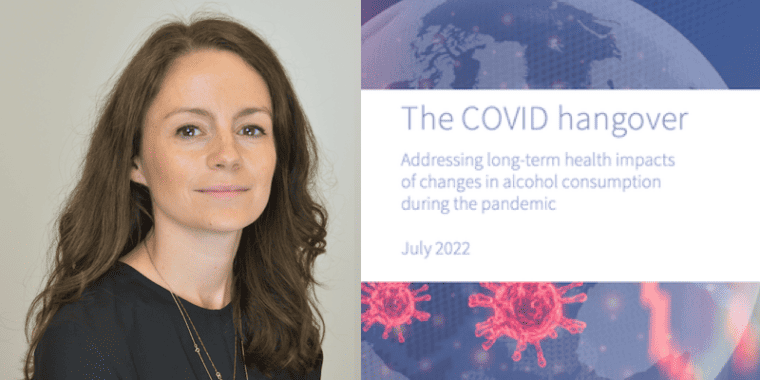
Previous blogs have covered how drinking patterns in the UK changed during the pandemic in 2020 and 2021. In short, hiding behind relatively flat alcohol sales overall, there has been a sustained rise in the proportion of people drinking at increasing or higher risk levels, as well as evidence that heavier drinkers increased their consumption the most.
Alcohol harm has also worsened considerably since the start of the pandemic. There was a 20% increase in alcohol-specific deaths in England and Wales in 2020, taking the figures to the worst on record, and again this pattern has persisted through 2021 and 2022. The increase has been concentrated among people living in more deprived areas, further widening inequalities in harm from alcohol.
In July we were pleased to launch our COVID Hangover report, a collaboration with HealthLumen, where we modeled the longer-term health and cost impact of changes in alcohol consumption patterns during COVID, funded by NIHR’s Policy Research Programme.
What did we do?
As early as June 2020, IAS and others were warning that there may be an increase in harm from alcohol as a result of changing drinking patterns and changes in access to healthcare. There was great uncertainty about what would happen to alcohol consumption as the pandemic progressed and restrictions were lifted, with little previous evidence to rely on. We created three different scenarios for future alcohol consumption to account for the uncertainty about future drinking patterns.
While we are now past the acute emergency response phase of the pandemic, the NHS and other public services have not recovered, and can ill-afford to deal with rising alcohol harm as an indirect effect of the pandemic. By modelling the future burden of disease we wanted to better understand the scale of the challenge.
Using HealthLumen’s microsimulation model together with a range of survey and healthcare data, we projected the impact of changes in alcohol consumption on future alcohol-related harm. We modelled what would happen to the rates of nine of the main diseases linked to alcohol (high blood pressure, stroke, liver disease, and six types of cancer) up to 2035.
The model projections are worrying
This microsimulation model projected that even if the changes seen to alcohol consumption are short-lived, there are knock-on effects on alcohol harm over the longer-term.
Depending on when and whether alcohol consumption returns to pre-pandemic patterns, the model projects there will be between 2,860 and 147,892 additional cases of the nine alcohol-related diseases studied in England by 2035. These cases are projected to lead to between 2,431 and 9,914 extra premature deaths (before the age of 75), which would fall disproportionately on those less well-off in society. The costs to the NHS of treating these nine diseases are estimated to be between £363 million and £1.2 billion.
In our project we have only modelled nine of 200+ diseases related to alcohol. This means that many other diseases, as well as other consequences such as harms to others, were not captured at all in our study. However a separate study using the Sheffield Alcohol Policy Model, released at the same time as our report, took a broader approach and shares similarly concerning findings.
Alcohol harm should be taken seriously as an indirect effect of the pandemic
Most of the health harm from alcohol is from chronic conditions, which take years to develop. The model projections to 2035 are not inevitable, if alcohol harm and the inequalities it entrenches are tackled.
In our report we recommend five areas for action:
- Increase funding and resources for alcohol treatment and support, over and above what was promised in 2021’s Drug Strategy
- Capitalise on the opportunities presented by the new alcohol duty system commencing in 2023
- Introduce minimum unit pricing for alcohol in England, aligning policy with Scotland and Wales
- Add protecting and improving public health as a fifth objective of the alcohol licensing system in England, as it is in Scotland
- Improve the regulatory approach to alcohol marketing to reduce exposure and influence among the vulnerable
We explain how action can be taken considering how hospitality has been hit by the pandemic, and also in terms of the cost-of-living crisis which we now face, which may bring its own consequences for alcohol harm and inequalities.
Read the 2-page summary of the report
Read the full IAS COVID Hangover report
Written by Dr Sadie Boniface, Head of Research, Institute of Alcohol Studies.
All IAS Blogposts are published with the permission of the author. The views expressed are solely the author’s own and do not necessarily represent the views of the Institute of Alcohol Studies
